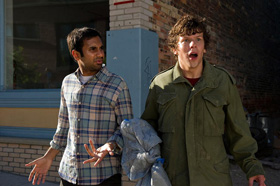 LOS ANGELES – In the action-comedy "30 Minutes or Less," Nick (Jesse Eisenberg) is a small town pizza delivery guy whose mundane life collides with the big plans of two wannabe criminal masterminds (Danny McBride and Nick Swardson). The lowlifes kidnap Nick and strap a time bomb to him – with the promise that they’ll blow him up unless he robs a bank. With only a few hours to pull off the impossible task, Nick enlists the help of his ex-best friend, Chet (Aziz Ansari). As the clock ticks, the two must deal with the police, hired assassins, flamethrowers, and their own tumultuous relationship.
LOS ANGELES – In the action-comedy "30 Minutes or Less," Nick (Jesse Eisenberg) is a small town pizza delivery guy whose mundane life collides with the big plans of two wannabe criminal masterminds (Danny McBride and Nick Swardson). The lowlifes kidnap Nick and strap a time bomb to him – with the promise that they’ll blow him up unless he robs a bank. With only a few hours to pull off the impossible task, Nick enlists the help of his ex-best friend, Chet (Aziz Ansari). As the clock ticks, the two must deal with the police, hired assassins, flamethrowers, and their own tumultuous relationship.
"30 Minutes or Less" began the road to the screen when the original action-comedy screenplay landed on the prestigious Black List, an inside-Hollywood tally of the best unproduced screenplays. Ruben Fleischer, who directs the screenplay into the new feature film, says that everyone involved with the project was first lured by the inventive spark of the screenplay and story. “It had a really original voice,” says the director. “I was excited to read a movie that wasn’t a straightforward, predictable comedy – it was hard to know where this movie was going when I was reading it.”
Part of what made the screenplay stand out was its outrageous premise: two lowlifes with more ambition than brains, Dwayne and Travis (Danny McBride and Nick Swardson), kidnap Nick (Jesse Eisenberg), a pizza delivery guy, and force him to rob a bank – putting a bomb around his chest as incentive. With no one else to turn to, Nick is forced back to his ex-best friend, Chet (Aziz Ansari). As the precious seconds tick away and Nick and Chet bicker about their present trouble and their troubled relationship, they wonder – will the bomb get them, or will they kill each other first?
But what truly made the material special was more than just its premise – it was also the wholly original characters and the way the film’s action and comic elements intertwined. The first filmmakers on board were producers Ben Stiller and Stuart Cornfeld of Red Hour Films, who developed the material. Cornfeld says that putting the characters – which he describes as equally “believable and eccentric” – into outrageous action sequences is a way of both raising the comedic stakes while also exposing unseen sides of the characters. “Action forces your character to dispense with any mask or disguise he might be wearing. The character might have a way he wants to appear to the outside world, but when he’s in crisis, he reverts back to exactly who he is – he has to be honest. That leads to the best comedy – it’s best when it’s truthful and relatable,” he says.
- Comment









